Con Etiquette and the Art of the Portfolio Review Part 1
At a recent Mid-South Cartoonists Association (MSCA) art show I had a high school student ask me to look at his work and give him some advice. It’s not the first time I’ve been asked this. It has happened a lot at comic conventions, book signings or MSCA meetings and events. I have to admit- it’s not one of my favorite things to do. It’s not that I don’t like sharing information, want to give advice, or not want to create competition for myself. I love talking art and passing along what I have learned over the years. I’ve had many artists, writers, editors, promoters, friends and family over the years give me some great advice and encouragement. Sometimes even when we had just met.
I guess some of my reservation in doing reviews at times is I feel like I’m still learning as an artist and creator. “Who am I to tell them what to do?” Some times I don’t want to hurt their feelings and am not sure what to say. Other times they draw better than I do and I’m just speechless! Then there are the times when I feel like they are not only wasting my time, but theirs, too.
I don’t mean that to sound as harsh as it probably comes across. Really…I’m a nice guy.
There are just times when you can tell no matter what you say it’s not going to make a difference. They stare off in the distance, get distracted by other things happening around them, look at the floor the whole time, constantly make excuses for their art, or worse they cop an attitude. I’ve met some who just don’t have any social skills- which is kind of important for networking at conventions and in the workplace.
I’ve seen all kinds of “portfolios” and have met artists of various ages, race, sex, education, and skill levels. Some have a real hunger to learn and a great passion for creating art. A few have some obvious self esteem issues (I can relate). Those are the folks I like to talk shop with and try to give some encouragement to. Then there are those that feel like Marvel and DC should give them an exclusive contract to draw Spiderman or Batman based off the few poorly drawn pin-ups they’ve shown around the con floor. “Learn anatomy? Heck, that’s for amateurs I’m ready for the big leagues right now!” They have already convinced themselves that they are great and if you don’t think so, well- you’re just wrong. Just ask their family and friends who think they’re awesome- they’ll tell ya!
There are also the artists who just don’t follow up, or add new work to their portfolios.
When I ran a t-shirt shop back in the 90’s, I would have “kids” like me come in for airbrushing advice. I had maybe one out of every dozen come back by later for a second visit, and even few of them actually bring a few photos or samples of what they had done. I rarely had anyone show me they were serious about learning. Most seemed to think it was a way to get rich quick venture, or that the airbrush actually did the work for you. I saw a lot of that when I worked in an art supply store. Many times I could tell what I was saying to a lot of them was going in one ear and out the other. Even with some of the artists I had working for me at the shop. They were young(er) and thought they knew everything there was to know. They had talent and potential- a lot of it, just not a lot of patience or a true desire to learn more.
(Me and one of my first airbrushed shirts- 1986)
When I wanted to learn how to airbrush I went around town to a few different shops and talked to the artists who worked there. One acted like he was too busy to talk to me. Another answered my questions but didn’t go out of his way to give away any “trade secrets”. The last artist- A.G. Howard, told me where to get some supplies and said he’d like to see some of my work. I went home and painted some quick cartoons and names on a sheet of posterboard. I took it back to the shop the next day and showed him. He liked what I had done but wanted to see some color work, and suggested that I practice on material called Pellon. He told me where to get some practice Pellon and showed me examples of what kind of designs he had done on it. I went by a fabric store and then home to paint. I showed up with my samples and a couple of tees. He told me about a job opening behind the counter at the shop and put in a good word for me. I got the gig and after a few weeks saved up to buy a new double action airbrush- another bit of advice he had given me. I started filling in on his and the other artist’s days off and soon was painting tees full time. Another artist- Greg Cravens, I had met at a local fair a year or so earlier. At the time he looked like a young Charles Manson so I was a bit apprehensive about talking to him. My mom convinced me to, and I’m glad she did. He was very friendly and more than happy to answer any questions I had. Almost 30 years later he’s not only still an art mentor, but is one of my best friends. Thankfully he no longer looks like a serial killer.
(Greg Cravens doing caricatures at the MSCA booth at the Mid-Sound Fairgrounds.)
When Greg stepped down as president of the MSCA, I got the position in the club. Before becoming “el Prez”, I had just been a cartoonist “wannabe” and rarely had anyone want to show me their work, even when I asked to see it. After I got the president position I was being shown portfolios, sketches, and told comic ideas left and right. Being in that kind of situation was new to me. How do I handle it? What do I tell them? Many times I just responded with, “Hey- cool. Looks/sounds great! Keep up the good work.” which is what a lot of them were just happy to hear. That was close to 20 years ago. I’ve seen a lot of portfolios since then, and have learned a lot as an artist- but it doesn’t make doing art reviews any easier for me these days. Ask someone how they “broke into comics” and you’ll probably hear a different story for each creator. There isn’t a “secret” for getting discovered- at least not one I’ve heard of or found!
(Me, Scott Clark, and Dave Beaty at the Bushi Tales booth at the San Diego Comic Con– 2007 )
Just before I became MSCA president my Bushi Tales co-creator buddy Dave Beaty and I had heard that former Image Comics artist Scott Clark was in town and searching for an art assistant. He was going to be looking at portfolios during an MSCA meeting hosted by Mike Ramirez at the Commercial Appeal. Mike worked there as the editorial cartoonist and would be doing portfolio reviews as well. Neither Dave or I had an actual portfolio, but had done enough work to put a couple together. We went to a local art store and each spent around $40 or so for some nice black zippered ones with 14″x17″ pages inside. Dave wanted a comic book portfolio, and I was going for more of a cartoon illustration and airbrush one. I had told one of the “young guns” who airbrushed at my shop about it and suggested he should do some nice sequential pages on Bristol (not pin-ups), put them in a portfolio, put on a clean shirt (this was the grunge era) and come by the meeting, too. Dave and I both decided to dress nice for the meeting- some slacks and a button up shirt, as well as putting on deodorant and brushing our teeth. Once there I actually had another member ask me, “What are you doing here..?” Have I mentioned social skills yet..? After showing our new portfolios to Mike and Scott and talking to some of the other cartoonists, I noticed the airbrush artist I had told about the meeting was there now and talking to Scott. He had just handed Scott a bunch of pin-ups and unfinished drawings done on typing paper- ugh! They had obviously been rolled up in his back pants pocket for the ride down to the meeting. The “young gun” was standing there making excuses for his art while wearing a tee two sizes too small and with what appeared to be stains from his lunch and/or dinner on the front. He looked like he hadn’t showered that day- more like rolled out of bed, rummaged through the dirty clothes hamper, and through on a ball cape backwards to cover up his bed hair and add to his unkempt appearance. Well, Dave got the assistant job, and he and Scott have done work together for Marvel and Aspen, and are currently working for DC Comics today. I saw the other artist a couple months ago at a local convention and he’s still wanting to break into comics.
(Jonnie Allan, Dave Beaty, and me at a PHX “Quick Draw” panel- 2009.)
Dave and I told that portfolio story at a panel on breaking into comics during the first Phoenix Comic Con I had attended a few years back. On the panel with us was artist Tone Rodriguez. Tone is amazingly good and fast at the “Quick Draw” panels at the Phoenix show. When asked how he presented his artwork at conventions Tone said, “I usually just carry mine around in a FedEx box. It’s the perfect size, and the boxes are free.” He’s worked on Simpsons and KISS comics. Apparently that type of portfolio works for him.
So, what advice to I give people? Well, some advice I learned the hard way, and other advice is what I’ve been told by other artists, editors, and art directors over the years:
-Don’t have more than 10-12 or less than 6 pieces in your portfolio.
-Don’t do pin-ups if you want to draw comics. Show 4-6 sequential story pages.
-Only show your best work. Better to have a few great samples than a lot of so-so or unfinished work. Never show someone else’s work!
-Keep your portfolio updated. Add new and better work and remove older pieces.
-Look and act professional. You don’t have to wear a suit and tie like Murphy Anderson, but do wear clean clothes, have good personal hygiene, and be on time.
-Don’t make excuses for your work. Stand there, take notes, answer their questions, don’t argue, and thank them when they are finished. If they are a bit vague with their criticism of your work, don’t be surprised. I like to ask (or be asked) if there is something specific to work on, or examples in my work that show it, but I don’t try to be pushy about it. Don’t monopolize their time. More than likely there’s a line behind you of other artists wanting to talk to that person, too.
-If you are showing your work to a creator who is at their own booth, don’t impede their sales. Be aware of customers or potential customers they may have. They are there to make money and are probably there on their own dime. Again, don’t monopolize their time.
-Have business cards handy and be ready to leave samples behind if asked- comics you’ve worked on, photocopies of comic pages, postcards, CD. etc. They may or may not ask. If you know that you are going to see them at an event go to their website or company’s website to see what they look for. Not everybody is looking for the same thing in a portfolio, or want to have it presented the same way. A little homework beforehand could go a long way to getting your work seen.
-Have a website with more of your work. Make the address your name or something easy to remember. Put that web address on all of your promotional materials. (No, Facebook or Deviant Art are not the same as having your own site.)
-Ask for their contact info and follow up later, but don’t be a pest.
-Work on your anatomy, backgrounds, and story telling. Even the pros need a refresher course in Comic Basics 101 now and then, and everyone can always improve no matter who they are.
-Look at self-publishing. Doing web comics, digital downloads, digital distribution, print on demand, etc. are much easier and cheaper to do than when I started self-publishing. Hone your skills and get creative working on your own project…and have fun!
In part 2 of this subject I’m going to ask some comic pros the dos and don’ts of portfolio reviews and how to submit a portfolio, including some advice for writers. I’m really doing this article to help me understand the portfolio review process and how to help review others when asked. I hope this series of blogs helps you, too.
Lin
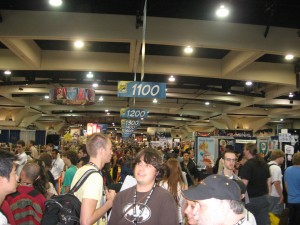
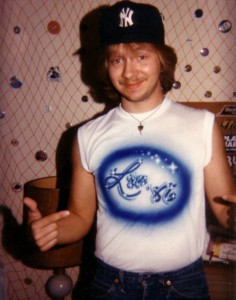
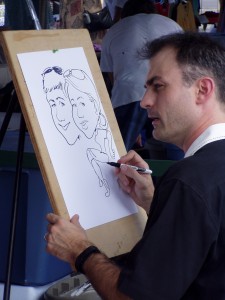
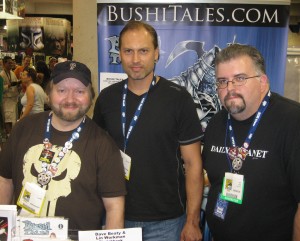
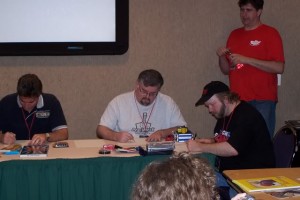
Comments are closed.